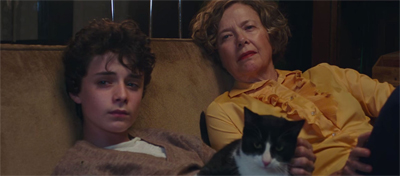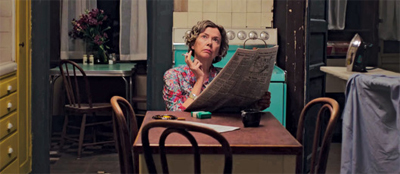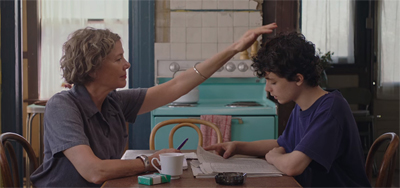20th Century Women is more affective than effective.
Mike Mills’ late seventies drama is far too quirky for its own good, often feeling more like a dramatised video essay than a narrative film. Mills provides a rake of social context for his story, from samples of Lodger to references to The Man Who Fell to Earth. He plays an extended section of President Jimmy Carter’s “Crisis of Conscience” address to the nation and even inserts some footage from Koyaanisqati. Characters monologue (and even dialogue) over careful compositions as the camera tracks across footage.

Making a splash.
Everything in 20th Century Women feels overstated. It is not enough to have characters quote extended passages from contemporary literature and poetry, Mills makes sure to cite his sources up on screen. The result is that 20th Century Women feels more like an annotated thesis statement than an engaging story. Mills keeps the camera at a distance from his characters, constantly moving through scenes instead of allowing them to develop organically. Everything is quirky and arch.
The result is that 20th Century Women suffocates its most interesting elements; its characters, its cast, its engagement with American masculinity and femininity on the cusp of Reaganism. This is a movie that strives so hard for authenticity that it only exposes its artifice.

Fanning the flame.
There are moments in 20th Century Women that work really well. Those moments typically invest in the characters, and trust the actors to carry the scenes. The actors are certainly game, with Annette Bening, Elle Fanning and Greta Gerwig doing good work. The most effective moments in 20th Century Women are content to allow those actors to exist in the moment, without the need for shoehorned context to their actions or emotions. The strongest moments in 20th Century Women trust these actors to tell their stories.
Dorothea Fields spends the movie trying to understand her son, and the film burdens its characters with heavy-handed narration and awkward exposition that treats the entirety of a human life as something that can be contextualised through a handful of observations. The characters in 20th Century Women often feel like the living embodiment of cause and effect, as much as they might deny it. The film’s insistence on following each character from their birth to their death reinforces this idea.

Seeing red.
Any number of small beats come to mind as authentic and well-observed human interactions. Repeatedly, Dorothea struggles with her son’s flirtation with punk music. Like many parents, she struggles to understand the appeal of angry young people shouting and thrashing to express themselves. However, in one delightful short sequence, Dorothea casts aside all those attempts to articulate the appeal. Instead, she simply allows herself to try to feel the music that her son listens to. It is a short, expressive sequence, but it feels organic and earned.
The characters seem truer in their smaller moments. Dorothea struggles with trying to understand her son, the central thematic and character arc of the film. In an unguarded moment, she confesses something like envy to her lodger Abbie. Abbie will have the opportunity to see Jamie out in the world, to witness his behaviour as a human being interacting free and unfetered. It is a beautiful expression of the limits to which a parent might know a child, the sense that James is a multifaceted person who belongs to more than his mother.

Watch out.
Unfortunately, the film struggles with many of the bigger beats. All the important moments feel a little too forced, a little too arch. When life challenges the characters in 20th Century Women, they respond like ironic caricatures rather than real people. At one point, a male character unexpectedly kisses Dorothea. “What was that?” she asks. “What does that mean?” It feels inorganic. At another point, two teenage characters lie in bed. Julie is the daughter of a therapist. “Let’s play therapy,” she earnestly suggests to her male friend.
Mills’ script is horrifically over-signified. It is a film set in 1979, on the cusp of the eighties. This should provide enough context, but instead the film insists on explaining absolutely everything to its audience. It navigates the second half of the twentieth century, jumping back and forward through time. Dorothea is contextualised as child of the Great Depression and the Second World War. Abbie is a baby boomer who becomes an artist. James and Julie are raised as children in the era of no fault divorce. Reaganism lies in wait, as does the internet and Y2K.

I read the news today, oh boy.
All of these observations are normally left unspoken or implied. Films like Everybody Wants Some!! or The Nice Guys operate with this vision of the seventies as a starting point, without needing to explain via voiceover that Nixon haunts the past and Reagan lurks in the future. 20th Century Women is so overt in its sense of historical context that it is surprising that no character ever explicitly acknowledges that Dorothea’s crumbling house is a metaphor for late seventies America. Leaving this unsaid might be the film’s most restrained choice.
Mills’ direction does not help matters. 20th Century Women is a film with a very short attention span, seemingly incapable of holding a still shot for any extended amount of time. Mills is constantly panning or zooming through the sets with Roger Neill’s soundtrack playing in the background, the camera seeming to drift idly through scenes rather than moving with any clear purpose. It seems trite when characters are monologuing over the scenes. It seems insulting when actors are actually performing, as if the camera cannot bother to hold its gaze.

The good boy project.
All of this is a massive shame, because there are any number of interesting ideas buried in 20th Century Women, from the generational clash of first- and second-wave feminists to the question of how to raise a “good man” to the silencing of women’s voices. These are all important and clever ideas, and there is certainly an interesting story to be told. It is hard to hate a movie that takes the time to ensure that its central male teenage character learns how to properly have sex. However, 20th Century Women is just too quirky to work.
20th Century Women is a misfire, one that is all the more frustrating for the short moments in which it does seem to come together.
Filed under: Non-Review Reviews | Tagged: 20th century women, annette bening, film, Movie, non-review review, review |




















Leave a comment